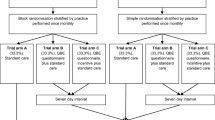Abstract
Background and aims: Postal questionnaires are widely used in health research to provide measurable outcomes in areas such as quality of life. Participants who fail to return postal questionnaires can introduce non-response bias. Previous studies within populations over the age of 65 years have shown that response rates amongst older people can be 60% or less. The current study sought to investigate whether envelope colour affected response rates in a study about the effectiveness of screening older women for osteoporosis. Methods: A total of 2803 eligible female participants aged between 70 and 85 were sent an invitation pack from their GP practice. The invitation was either in a brown or white envelope and contained a matching pre-paid reply envelope. A study questionnaire was also sent out in brown or white envelopes 1 week after consenting to participate in the trial. Results: The overall response rate was 78%. There was little evidence of an effect of envelope colour on response to the invitation to participate in the trial (OR 1.04, 95% CI 0.87–1.24). Similarly, there was no influence of envelope colour on the number of participants returning their questionnaires (OR 0.99, 95% CI 0.60–1.63). There was weak evidence of an effect of envelope colour on the response rates of the consent process (OR 0.86, 95% CI 0.74–1.00). When we updated a recent meta-analysis with the results of this study, there was a non-statistically- significant trend for greater response rates with brown envelopes compared with white envelopes (OR 1.19, 95% CI 0.86–1.64, I2=92%). However, the results where influenced by one study and when this study was excluded the pooled estimate was 0.98 (95% CI 0.89–1.08, I2=0%). Conclusion: This study found no evidence to suggest envelope colour has an effect on response to participate in a trial or questionnaire returns. There is weak evidence to suggest envelope colour may affect consent into a trial.
Similar content being viewed by others
References
Edwards PJ, Roberts IG, Clarke MJ et al. Methods to increase response rates to postal questionnaires. Cochrane Database Syst Rev 2009 (Issue 3. Art. No.: MR000008. DOI: 10.1002/ 14651858.MR000008.pub4.).
Smeeth L, Fletcher AE. Improving the response rates to questionnaires. BMJ 2002; 324: 1168–9.
Taylor KSM, Counsell CE, Harris CE, Gordon JC, Fonseca SCC, Lee AJ. In a randomized study of envelope and ink colour, coloured ink was found to increase the response rate to a postal questionnaire. J Clin Epidemiol 2006; 59: 1326–30.
Hardie JA, Bakke PS, Mørkve O. Non-response bias in a postal questionnaire survey on respiratory health in the old and very old. Scand J Public Health 2003; 31: 411–7.
Paganini-Hill A, Hsu G, Chao A, Ross RK. Comparison of early and late respondents to a postal health survey questionnaire. Epidemiology 1993; 4: 375–9.
McCoy M, Hargie O. Effects of personalization and envelope color on response rate, speed and quality among a business population. Industrial Marketing Management 2007; 36: 799–809.
Newland CA, Waters WE, Standford AP, Batchelor BG. A study of mail survey method. Int J Epidemiol 1977; 6: 65–7.
Roberts I, Coggan C, Fanslow J. Epidemiological methods: The effect of envelope type on response rates in an epidemiological study of back pain. J Occup Health Safety Aust NZ 1994; 10: 55–7.
Wright SJ. Mail survey response rates: A test of four techniques designed to increase response rates and a discussion of the associated cost considerations. Student Research Report. Massey, New Zealand: Department of Marketing, Massey University, 1984.
SCOOP: Screening of Older Women for Osteoporotic Fracture Prevention. Available at: http://www.scoopstudy.ac.uk. Accessed: 2008 1st August.
Torgerson DJ, Torgerson CJ. Designing randomised trials in health, education and the social sciences. Basingstoke: Palgrave Macmillan, 2008.
Iglesias CP, Birks YF, Torgerson DJ. Improving the measurement of quality of life in older people: the York SF-12. Q J Med 2001; 94: 695–8.
EuroQol: EQ5D. Available at: http://www.euroqol.org/. Accessed: 2008 1st August.
Spielberger CD. Manuel for the State-Trait Anxiety Inventory (STAI). Palo Alto, CA: Consulting Psychologists Press, 1983.
Edwards P, Roberts I, Clarke M et al. Increasing response rates to postal questionnaires: Systematic review. BMJ 2002; 324: 1183–91.
Author information
Authors and Affiliations
Consortia
Corresponding author
Rights and permissions
About this article
Cite this article
Mitchell, N., Hewitt, C.E., Torgerson, D.J. et al. A controlled trial of envelope colour for increasing response rates in older women. Aging Clin Exp Res 23, 236–240 (2011). https://doi.org/10.1007/BF03337749
Received:
Accepted:
Published:
Issue Date:
DOI: https://doi.org/10.1007/BF03337749




